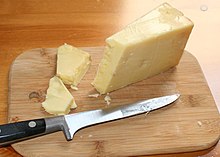Sharp cheddar
| Cheddar cheese | |
|---|---|
 |
|
| Country of origin | United Kingdom |
| Region | Somerset |
| Town | Cheddar |
| Source of milk | Cows |
| Pasteurised | Frequently |
| Texture | Hard |
| Aging time | 3–18 months depending on variety |
| Certification | West Country Farmhouse Cheddar PDO, Orkney Scottish Island Cheddar PGI |
Cheddar cheese is a relatively hard, off-white (or orange if spices such as annatto are added), sometimes sharp-tasting (i.e., bitter), natural cheese. Originating in the British village of Cheddar in Somerset, cheeses of this style are produced beyond this region and in several countries around the world.
Cheddar is the most popular type of cheese in the UK, accounting for 51% of the country's £1.9 billion annual cheese market. It is also the second-most-popular cheese in the US (behind mozzarella), with an average annual consumption of 10 lb (4.5 kg) per capita. The US produced approximately 3,000,000,000 lb (1,300,000 long tons; 1,400,000 tonnes) in 2014, and the UK 258,000 long tons (262,000 tonnes) in 2008.
The term "Cheddar cheese" is widely used, but has no Protected Designation of Origin within the European Union. However in 2007, a Protected Designation of Origin, "West Country Farmhouse Cheddar", was created and only Cheddar produced from local milk within Somerset, Dorset, Devon and Cornwall and manufactured using traditional methods may use the name. Outside of Europe, the style and quality of cheeses labelled as cheddar may vary greatly; furthermore, cheeses that are more similar in taste and appearance to Red Leicester are sometimes popularly marketed as "Red Cheddar".
The cheese originates from the village of Cheddar in Somerset, south west England. Cheddar Gorge on the edge of the village contains a number of caves, which provided the ideal humidity and steady temperature for maturing the cheese. Cheddar cheese traditionally had to be made within 30 mi (48 km) of Wells Cathedral.
Cheddar has been produced since at least the 12th century. A pipe roll of King Henry II from 1170 records the purchase of 10,240 lb (4,640 kg) at a farthing per pound (totalling £10.13s.4d).Charles I (1600–1649) also bought cheese from the village.Romans may have brought the recipe to Britain from the Cantal region of France.
...
Wikipedia
